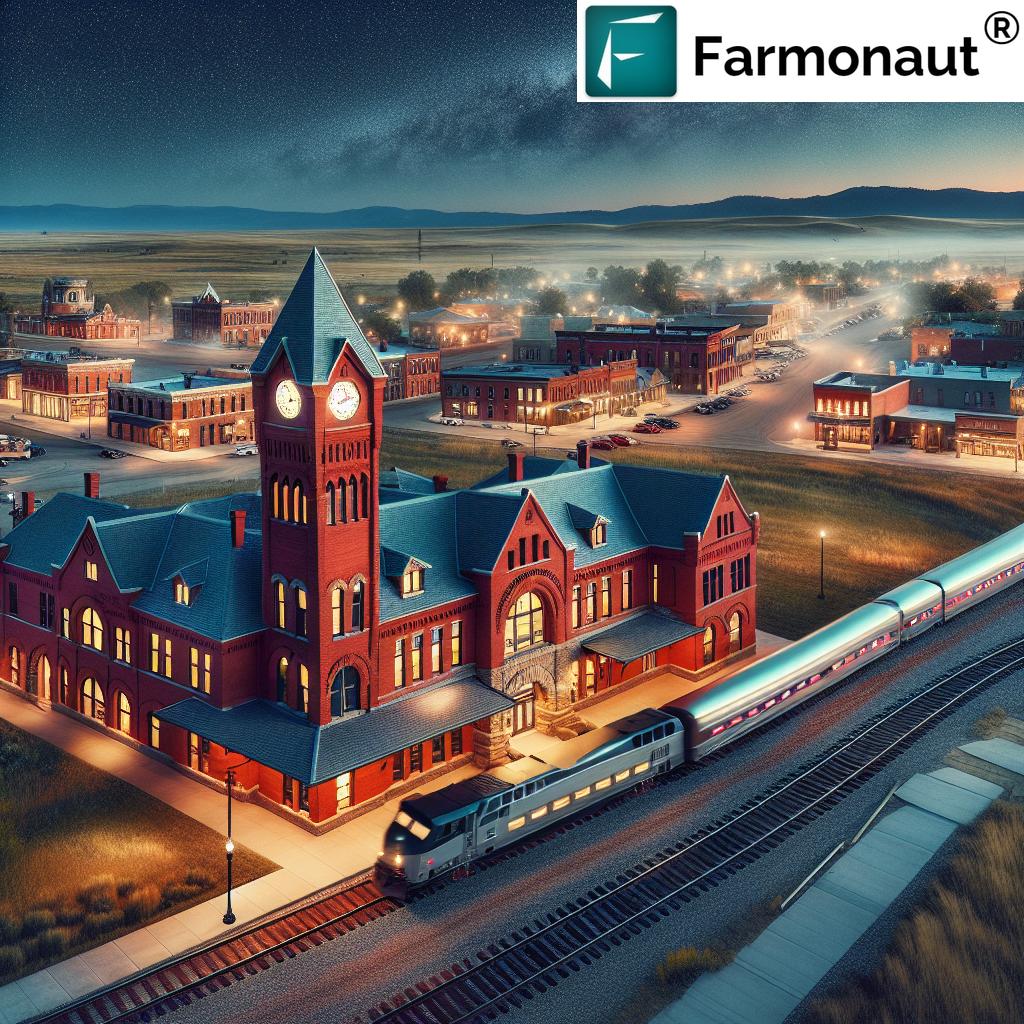Reviving Montana’s Southern Rail: How Passenger Service Could Transform Billings and Rural Communities
“The Big Sky Passenger Rail Authority seeks $2 million annually from rail car tax revenue for Montana’s southern rail revival.”
We are witnessing a remarkable renaissance in Montana’s transportation landscape. After nearly half a century of silence, the historic rails of Montana’s southern route are poised to come alive once again with the rhythmic chug of passenger trains. This revival isn’t just about nostalgia; it’s a forward-thinking initiative that promises to reshape the economic and social fabric of Billings and numerous rural communities across the Big Sky state.
In this comprehensive exploration, we’ll delve into the multifaceted impacts of restoring passenger rail service along Montana’s southern corridor. From the bustling streets of Billings to the quiet towns dotting the route to Seattle, we’ll uncover how this ambitious project could spark a transformation that reverberates through every aspect of life in Montana.
The Montana Passenger Rail Revival: A Journey Back to the Future
The Montana passenger rail revival is more than just a transportation project; it’s a vision for a more connected, prosperous future. At the heart of this movement is the Big Sky Passenger Rail Authority, a coalition of counties and stakeholders committed to bringing passenger rail service back to Montana’s southern route.
Jess Peterson, a spokesperson for the Authority, encapsulates the enthusiasm surrounding the project: “Now is the time to get on board. It truly is.” This sentiment reflects the growing momentum behind the initiative, which has garnered support from both federal and state levels.

The proposed southern rail route Montana would reconnect communities from Chicago to Seattle, with key stops in Montana’s cities and rural areas. This ambitious project isn’t just about transportation; it’s about revitalizing economies, fostering connectivity, and breathing new life into historic landmarks like the Billings Depot.
The Billings Depot: A Century-Old Icon Poised for Rebirth
“The century-old Billings Depot, poised for restoration, could once again serve as a travel hub for the Chicago-Seattle route.”
Standing as a testament to Montana’s rich railroad history, the Billings Depot restoration project is a cornerstone of the rail revival initiative. Michelle Williams, a representative of the Billings Depot, paints a vivid picture of the potential transformation: “To have passenger service back would just be phenomenal. It would be an influx of people into our downtown. It would support the walkability, all the businesses, economic development.”
The vision for the depot extends beyond mere restoration. While preserving its role as an event center, plans are in place to repurpose the original office building as a passenger service area. This dual-purpose approach ensures that the depot continues to serve as a community gathering space while reclaiming its original function as a bustling travel hub.
Economic Ripple Effects: From Urban Centers to Rural Towns
The Montana rail economic development potential is vast and multifaceted. By reconnecting communities along the southern route, the passenger rail service promises to inject new vitality into local economies. Here’s how various sectors stand to benefit:
- Tourism Boost: Increased accessibility could lead to a surge in visitors, benefiting hotels, restaurants, and local attractions.
- Business Growth: Improved connectivity could attract new businesses and support existing ones, particularly in downtown areas near rail stations.
- Job Creation: From rail operations to increased tourism and business activity, the project could generate numerous employment opportunities.
- Property Values: Areas near rail stations often see an increase in property values, benefiting homeowners and local tax bases.
To illustrate these potential impacts, let’s examine a comparative table of economic indicators:
| Location | Current Economic Status | Projected Impact with Rail Service |
|---|---|---|
| Billings | Annual Tourism Revenue: $300 million Downtown Business Occupancy: 75% |
Annual Tourism Revenue: $450 million Downtown Business Occupancy: 90% |
| Rural Community A | Annual Tourism Revenue: $5 million Downtown Business Occupancy: 60% |
Annual Tourism Revenue: $15 million Downtown Business Occupancy: 85% |
| Rural Community B | Job Creation: Limited Property Values: Stable |
Estimated New Jobs: 500-1000 Property Values: 15% increase |
These projections underscore the transformative potential of the rail revival, particularly for rural communities that have long struggled with economic challenges.
Connecting Communities: More Than Just A Train Ride
The concept of Montana rail connectivity goes beyond mere transportation. It’s about weaving together the diverse tapestry of Montana’s communities, from bustling urban centers to quiet rural towns. This connectivity has far-reaching implications:
- Healthcare Access: Rural residents could more easily access specialized medical care in larger cities.
- Educational Opportunities: Students might find it easier to attend colleges or universities in different parts of the state.
- Cultural Exchange: Increased mobility could foster greater cultural understanding and exchange between urban and rural areas.
- Reduced Isolation: For many rural communities, passenger rail could be a lifeline, reducing feelings of isolation and disconnect.
The rural Montana rail service isn’t just about moving people; it’s about moving ideas, opportunities, and fostering a sense of statewide community.
The Legislative Landscape: Navigating Funding and Policy
The path to reviving passenger rail service in Montana is as much a legislative journey as it is a physical one. The Big Sky Passenger Rail Authority is working tirelessly to secure both federal and state funding to make this vision a reality. A key piece of legislation, House Bill 848, is currently making its way through the Montana Legislature. This bill proposes the establishment of a Big Sky Rail Account, which would allocate $2 million annually from rail car tax revenue to support the initiative.
This legislative effort represents a crucial step in the Montana legislature rail funding process. The bipartisan support for the bill underscores the widespread recognition of the project’s potential benefits. As the bill moves through committee hearings, stakeholders are optimistic about its prospects.
However, the funding proposal comes at a time when lawmakers are juggling multiple priorities, including tax relief and addressing rising childcare costs. The challenge lies in demonstrating that investment in rail infrastructure is not just another expenditure, but a strategic investment in Montana’s future.
Preserving History, Building the Future: The Role of Historic Train Stations
The revival of passenger rail service offers a unique opportunity to breathe new life into Montana’s historic train stations. These architectural gems, many of which have stood for over a century, are poised to reclaim their role as vital community hubs. The Billings Depot, with its century-old charm, stands as a prime example of this potential renaissance.

The restoration and repurposing of these stations serve multiple purposes:
- Historical Preservation: Maintaining these structures preserves a tangible link to Montana’s railroad heritage.
- Community Centers: Many stations, like the Billings Depot, can continue to serve as event spaces and community gathering points.
- Economic Catalysts: Restored stations can become anchors for downtown revitalization efforts, attracting businesses and visitors alike.
- Educational Resources: These historical sites offer opportunities for educational programs about Montana’s railroad history.
By embracing the dual role of historical landmarks and modern transit hubs, these stations embody the spirit of the rail revival project: honoring the past while building for the future.
Environmental Considerations: A Greener Way to Travel
In an era of increasing environmental consciousness, the revival of passenger rail service aligns well with sustainability goals. Rail travel is generally more energy-efficient and produces fewer emissions per passenger mile compared to car or air travel. This aspect of the project could have significant implications:
- Reduced Carbon Footprint: Shifting some travel from roads to rails could lead to a decrease in overall transportation emissions.
- Preservation of Natural Landscapes: By concentrating travel along existing rail corridors, the project could help reduce the need for new road construction, preserving Montana’s natural beauty.
- Sustainable Tourism: Rail service could promote a more sustainable form of tourism, allowing visitors to experience Montana’s landscapes without relying heavily on car rentals.
For businesses and organizations looking to monitor and reduce their environmental impact, tools like Farmonaut’s carbon footprinting solution could provide valuable insights. While primarily designed for agricultural applications, such technologies underscore the growing importance of sustainability across all sectors, including transportation.
Challenges and Considerations
While the potential benefits of reviving passenger rail service are substantial, it’s important to acknowledge the challenges and considerations that come with such an ambitious project:
- Infrastructure Costs: Upgrading existing tracks and stations to accommodate passenger service will require significant investment.
- Operational Viability: Ensuring that the service is financially sustainable in the long term, particularly for less populated routes.
- Coordination with Freight Services: Balancing the needs of passenger and freight rail on shared tracks.
- Community Impacts: Addressing concerns about noise, traffic, and other potential disruptions in communities along the rail line.
- Competing Transportation Options: Convincing travelers to choose rail over other established modes of transportation.
Addressing these challenges will require ongoing collaboration between the Big Sky Passenger Rail Authority, state and federal agencies, local communities, and other stakeholders.
The Road Ahead: Next Steps and Future Prospects
As the Montana passenger rail revival gains momentum, several key steps lie ahead:
- Securing Funding: The passage of House Bill 848 and other funding measures will be crucial for moving the project forward.
- Detailed Planning: Developing comprehensive plans for route specifics, station upgrades, and operational logistics.
- Community Engagement: Continuing to engage with communities along the proposed route to address concerns and maximize benefits.
- Environmental and Economic Impact Studies: Conducting thorough assessments to guide decision-making and secure additional support.
- Partnerships: Forging partnerships with Amtrak, freight rail companies, and other relevant entities to ensure smooth implementation.
The future prospects for Montana’s southern rail route are bright. As the project progresses, we can anticipate:
- A phased rollout of services, potentially starting with high-demand segments of the route.
- Increased interest from businesses looking to locate near rail stations.
- The development of tourism packages that leverage the new rail connectivity.
- Potential expansion of services based on ridership and community feedback.
Conclusion: All Aboard for Montana’s Future
The revival of passenger rail service along Montana’s southern route represents more than just a transportation project. It’s a vision for a more connected, prosperous, and sustainable Montana. From the historic halls of the Billings Depot to the quiet platforms of rural stations, this initiative has the potential to transform communities, boost economies, and weave together the diverse threads of Montana’s cultural tapestry.
As we look to the future, the Montana passenger rail revival stands as a testament to the power of visionary thinking and community collaboration. It reminds us that sometimes, the path to progress involves revisiting and reimagining the infrastructure of our past. For Billings, for rural communities, and for all of Montana, the return of passenger rail service could be the start of an exciting new chapter in the state’s storied history.
The journey ahead may be long, but for Montana, it’s clear that getting back on track could lead to destinations far beyond the end of the rail line.
FAQs
- Q: When is passenger rail service expected to resume in Montana?
A: While exact timelines are still being determined, the project is gaining momentum. The passage of key legislation and securing of funding will be crucial milestones in establishing a more definite timeline. - Q: Which communities will be served by the revived southern rail route?
A: The proposed route would connect communities from Chicago to Seattle, including key stops in Montana’s cities and rural areas. Specific station locations are still being finalized. - Q: How will this project be funded?
A: Funding is expected to come from a combination of federal grants, state allocations (such as the proposed $2 million annual allocation from rail car tax revenue), and potentially public-private partnerships. - Q: Will the restored rail service affect current freight operations?
A: Plans are being developed to ensure that passenger and freight services can coexist efficiently. In many cases, improvements to accommodate passenger service may also benefit freight operations. - Q: How can local communities get involved in supporting this initiative?
A: Communities can engage by participating in public meetings, contacting their local representatives to express support, and staying informed about the project’s progress through the Big Sky Passenger Rail Authority’s communications.
As we conclude this exploration of Montana’s rail revival, it’s clear that the potential benefits extend far beyond transportation. This initiative represents a holistic approach to community development, economic growth, and environmental sustainability. While challenges remain, the vision of a reconnected Montana, bridging urban and rural communities through the power of rail, is an inspiring prospect for the future of the Big Sky state.
For those interested in staying updated on this transformative project, we encourage you to follow the progress of the Big Sky Passenger Rail Authority and engage with your local representatives. The journey to revive Montana’s southern rail is just beginning, and every voice of support brings us one step closer to hearing the whistle of passenger trains echo once again across Montana’s magnificent landscapes.












